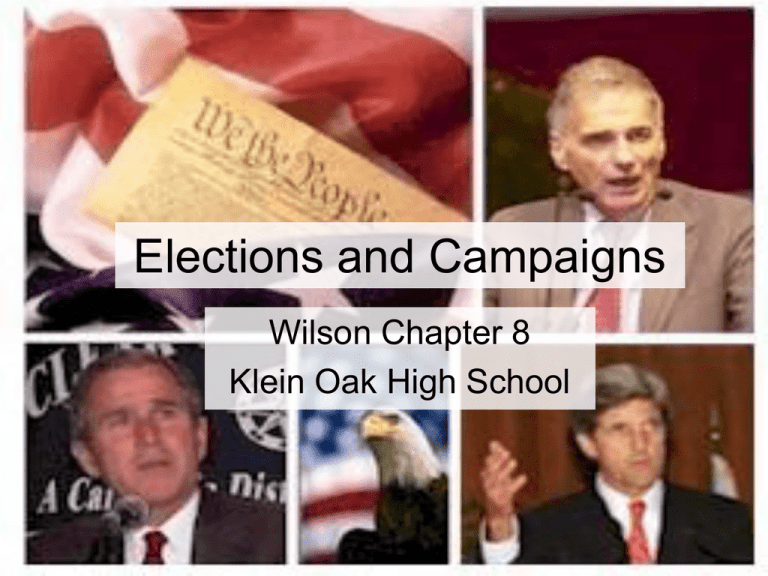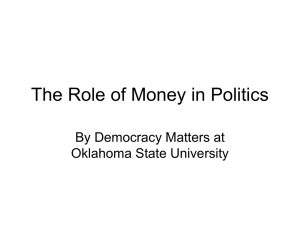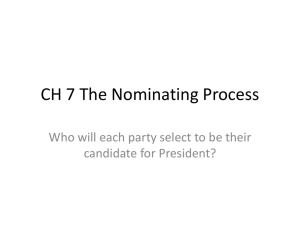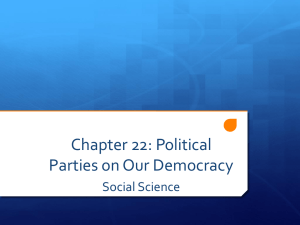PPT - Klein Oak.org
advertisement

Elections and Campaigns Wilson Chapter 8 Klein Oak High School Congressional vs. Presidential 1 • Two phases – getting nominated and – getting elected • Getting nominated – Getting your name on the ballot – An individual effort – U.S. parties now stress label more than organization – Parties used to play larger role Congressional vs. Presidential 2 • Presidential races are more competitive than House races. – White House has made more partisan changes than the House. – Winning margins are narrower for presidential races. – Term limits cut a president’s incumbency advantage. • e.g. Al Gore in 2000 Congressional vs. Presidential 3 • Fewer people vote in midterm elections. – Candidates must appeal to more partisan and activist voters. • Congressional incumbents can serve their constituents. – Credit for government grants, programs, etc., can be claimed by Congress member via mailings and visits home. – President can’t (power is not local) and must communicate by mass media Congressional vs. Presidential 4 • Congressional candidates can campaign against Washington. – President is held accountable. – But congressional candidates suffer when their party’s economic policies fail. • Power of presidential coattails has declined – Congressional elections have become largely independent of presidential election. – Reduces meaning (and importance) of party Running for President 1 • Getting mentioned as being presidential caliber – Using reporters, trips, speeches – Sponsoring legislation, governor of large state • Setting aside time to run – Reagan: six years; – Mondale: four years • May have to resign from office first (Dole in 1996), though many campaign while in office Running for President 2 • Money – Individuals can give $1,000, – PACs can give $5,000 in each election to each candidate. – Qualifying for matching funds for primaries • Candidates must raise $5,000 in twenty states in individual contributions of $250 or less Running for President 3 • Organization – large paid staff • e.g., Kerry Campaign Staff – volunteers – advisers on issues Running for President 4 • Strategy and themes – Incumbents defend their record; challengers attack incumbents. – Setting the tone (positive or negative) – Developing a theme: “trust,” “confidence,” etc. – Judging the timing (early momentum vs. reserving resources for later) – Choosing a target voter: who’s the audience? Who will change their vote? Primary and General Campaigns • What works in a primary election may not work in a general election, and vice versa. – Different voters, workers, media attention – Must mobilize activists who will give money, volunteer, and attend caucuses – Activists are more ideologically stringent than are the voters at large. Iowa Caucuses • Held in January (text is wrong) of presidential election year • Candidates must do well or be disadvantaged in media attention, contributor interest • Winners tend to be most liberal Democrat, most conservative Republican The Balancing Act • Being conservative enough or liberal enough to get nominated • Then move to center to get elected • Apparent contradictions can alienate voters from all candidates. • Even primary voters can be more extreme ideologically than average voters; – e.g., McGovern in 1972 Two Kinds of Campaign Issues • Position issues: – rival candidates have opposing views, – voters are divided and a partisan realignment may result • Position issues in 2000: social security, defense, public school choice systems • Valence issues: – candidate supports the public, widely held view – Dominated the 1996 election – Increasingly important because television leads to a reliance on popular symbols and admired images Television • Paid advertising (spots) – Little known candidates can increase name recognition through the frequent use of spots (example, Carter in 1976). – Probably less effect on general than primary elections because most voters rely on many sources for information • News broadcasts (“visuals”) – – – – Cost little May have greater credibility with voters Rely on having television camera crew around May actually be less informative than spots and therefore make less of an impression Debates • Usually an advantage only to the challenger • Reagan in 1980: – reassured voters by his performance • 1988 primary debates with little impact on voters Slips of the Tongue • Risk in debates and visuals • Forces candidates to rely on stock speeches—campaign themes and proven applause-getting lines • Sell yourself as much or more than ideas Ross Perot’s Campaign • depended on television. – CNN appearances – Infomercials – Televised debates with major party contenders The Computer • Makes possible direct-mail campaigns • Allows candidates to address specific voters via direct mail • Mailing to specific groups, so more specific views can be expressed Gap Between Campaigning & Governing • Has been widening in recent years – Party leaders had to worry about their candidates’ reelection so campaigning and government linked – Today’s consultants work for different people in different elections—no participation in governing. The Sources of Campaign Money 1 • Presidential primaries: – part private, – part public money – Federal matching funds for all individuals’ donations of $250 or less – Gives candidates an incentive to raise money from small donors – Government also gives lump-sum grants to parties to cover convention costs. The Sources of Campaign Money 2 • Presidential general elections: – all public money – 1996: • $61.8 million for major party candidates, • $29 million for Perot The Sources of Campaign Money 3 • Congressional elections: – all private money • individuals, • political action committees, and • political parties – Most money comes from individual small donors ($lOO—$200 a person). – $1,000 maximum for individual donors – Benefit performances by rock starts, etc., can raise large amounts of money. – $5,000 limit for PACs • but most give just a few hundred dollars – Incumbents receive one-third of their campaign funds from PACs and spend little of their own money. – Challengers must supply much of their own money. Campaign Finance Rules 1 • Watergate and illegal donations from corporation, unions, and individuals • Brought about the 1974 federal campaign reform law and Federal Election Commission (FEC) Campaign Finance Rules 2 • Reform law – Set limit on individual donations ($1,000) per candidate per election) – Reaffirmed ban on corporate and union donation... – but allowed them to raise money through PACs – PACs in turn raised money from members or employees – Set limit on PAC donations ($5,000 per election per candidate) – Primary and general election counted separately for donations Campaign Finance Rules 3 • Supreme Court ruled that limits could not be set on campaign spending by an individual candidate unless federal funding was being received. – Buckley v. Valeo • Limit of $50,000 on out-of-pocket spending by a presidential candidate who accepted federal financing Campaign Finance Rules 4 • Law did not limit independent political advertising—no consultation with candidate or campaign organization – Typically done by ideologically oriented PACs – Sometimes negative or attack advertising is involved Campaign Finance Rules 5 • Loopholes in the law – Allows soft money—money for local party activities, e.g., getting out the vote – Allows bundling • “The practice of pooling individual contributions from various people -- often those employed by the same business or in the same profession -- in order to maximize the political influence of the bundler. “ (source) Effects of Reform • Goal: To expose and publicize fundraising • Successful, but it has limitations – greatly increased power of PACs and thus of special interests – shifted control of money away from parties to candidates – given advantage to wealthy challengers – given advantage to ideological candidates – penalized candidates who start campaigning late, who don’t have war chests – helped incumbents and hurt challengers Campaign Finance Reform • Further reforms may be unconstitutional and also unsuccessful. • Popular, questionable reforms: – Cut individual donations – Free advertising for candidates – Ban soft money – Federal funding – Abolish PACs Money and Winning 1 • Presidential candidates have similar funds because of federal funding, but parties may have different amounts of soft money. • Other factors whose influence on the presidential campaign is usually overstated: – – – – – Vice presidential nominee Political reporting Religion of the presidential candidate Abortion as a single issue New voting groups • Party affiliation, state of the economy, and candidate character influences voting in presidential elections. Money and Winning 2 • Congressional races—money has a greater effect – [Your teacher disagrees with Wilson on this. Recent economic studies show little correlation.] – Challenger must spend to be recognized. – Jacobson: big spending challengers do better – Big spending incumbents also do better and higher spending has become the norm. – [Your teacher questions whether the money produced success or, more likely, likely success attracted money.] Money and Winning 3 • Money doesn’t make the only difference. – Party, incumbency, and issues also have a role. • Advantages of incumbency, in fundraising – Can provide services to constituency – Can use franked mailings – Can get free publicity by sponsoring legislation or conducting investigations Money and Winning 4 • Ideas for reform – Unlikely: Congress won’t agree since incumbent had advantage – The “constitutional right to campaign” involved – Public financing of congressional races would give incumbents even more of an advantage. – Abolishing PAC money might allow fat cats to reemerge as a major force – Shorter campaigns might help incumbents. What Decides Elections? - an overview • • • • Party Identification Issues The Campaign Finding a Winning Coalition Party Identification • Why don’t Democrats always win? – Democrats less wedded to their party than are Republicans – GOP does better among independents. – Republicans have higher turnout. Issues 1 • “It’s the economy, stupid!” • V. 0. Key: most voters who switch parties do so in their own interests – They know what issues affect them personally. – They have strong principles about certain issues (abortion, etc.). • Prospective voting is used by relatively few voters. – Those voters know the issues and vote accordingly. – Most common among activists and special interest groups Issues 2 • Retrospective voting practiced by most voters, and decides most elections – Judge the incumbent’s performance and vote accordingly – Have things gotten better or worse, especially economically? • Reagan in 1980 debate – Examples: presidential campaigns of 1980, 1984, 1988, 1992, 1996 – Usually helps incumbent.., unless economy has gotten worse – Midterm elections: voters turn against president’s party • 2002 exception (war) The Campaign • Does make a difference – reawaken voters’ partisan loyalties – let voters see how candidates handle and apply pressure – let voters judge candidates’ characters and core values • Tend to emphasize themes over details – True throughout American history – What has changed is importance of primary elections – Gives more influence to single-issue groups with loyal members who vote as a block Finding a Winning Coalition 1 • Ways of looking at various groups – How loyal, or percentage voting for party – How important, or number voting for party Finding a Winning Coalition 2 • Democratic Coalition – Blacks most loyal – Jews slipping somewhat – Hispanics somewhat mixed because of underlying ethnic differences • Political power does not yet match numbers. • Turnout will increase as more become citizens. • See box, The Hispanic Vote. Finding a Winning Coalition 3 • Republican Coalition – Party of business and professional people who are very loyal • exception: 1964 (AuH2O!) – Farmers are often Republican, but are changeable. • Representatives of different segments of the coalition stress loyalty or numbers, because can rarely claim both Party Realignments 1 • Definition: sharp, lasting shift in the popular coalition supporting one or both parties occurring during an election or early in a presidential administration • Issues that distinguish the parties change, so supporting voters change for each party. – – – – – 1800: Jeffersonians defeated Federalists 1828: Jacksonian Democrats came to power 1860: Whigs collapsed; Republicans won (Lincoln) 1896: Republicans defeated William Jennings Bryan 1932: FDR Democrats came to power Party Realignments 2 • Kinds of realignments – Major party is so badly defeated that it disappears and new party emerges • 1800 • 1860 – Parties continue, but voters shift from one party to another • 1896 • 1932 Party Realignments 3 • Clearest cases of realignment – 1860: slavery – 1896: economics – 1932: economics • 1980 not a traditional realignment – Dissatisfaction with Carter led to Reagan victory. – Also left Congress Democratic Party Realignments 4 • Major change in 1972—1996: shift in presidential voting patterns in the South – Southern whites: • fewer Democrats, • more Republicans, • more independents – Southern white independents vote Republican. – Given votes of independents, southern whites are now close to fifty-fifty Democratic, Republican. • In general, party de-alignment, not realignment, because party labels lost meaning for so many voters. Party Decline • Fewer people identify with either party. • Increase in ticket splitting, which creates divided government • Seeing the effect of a change from the party-column ballot to the office-bloc ballot Guess which one is the party column ballot and which one is the office bloc ballot. The image is taken from Magruder’s American Government. Effects of Election on Policy 1 • Argument: Public policy remains more or less the same no matter which official or party is in office. – Depends on the office and the policy – Voters must elect numerous officeholders. – Parties have a limited ability to build coalitions of officeholders. – Winning coalitions may change from policy to policy. Effects of Election on Policy 2 • Comparison: Great Britain, with parliamentary system and strong parties, often sees marked changes, as in 1945 and 1951. • Conclusion: Many American elections do make differences in policy, though constitutional system generally moderates the pace of change. Effects of Election on Policy 3 • Why, then, the perception that elections do not matter? – Because change alternates with consolidation; – most elections are retrospective judgments about the incumbent president and existing congressional majority. The End!









